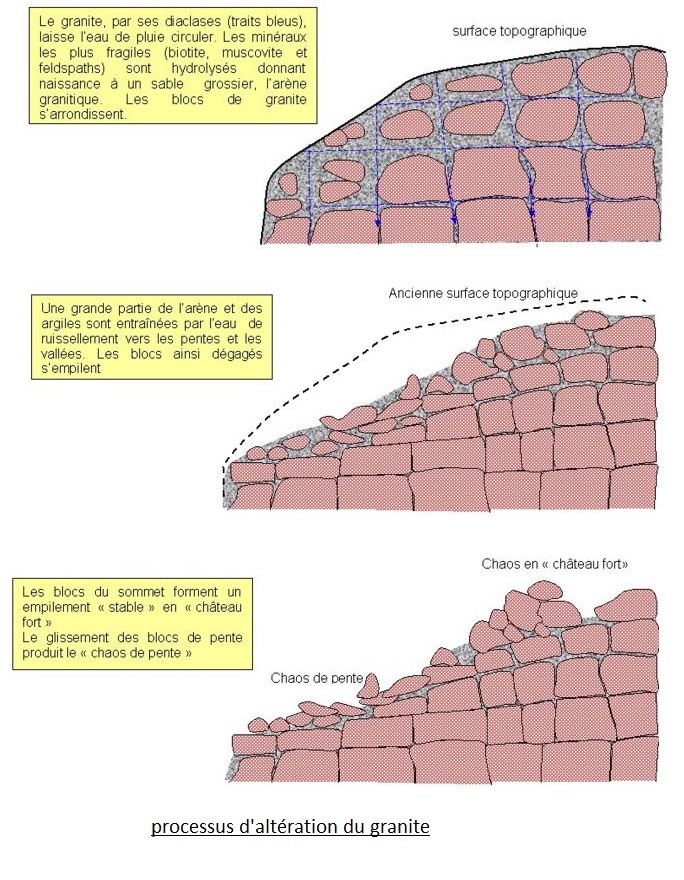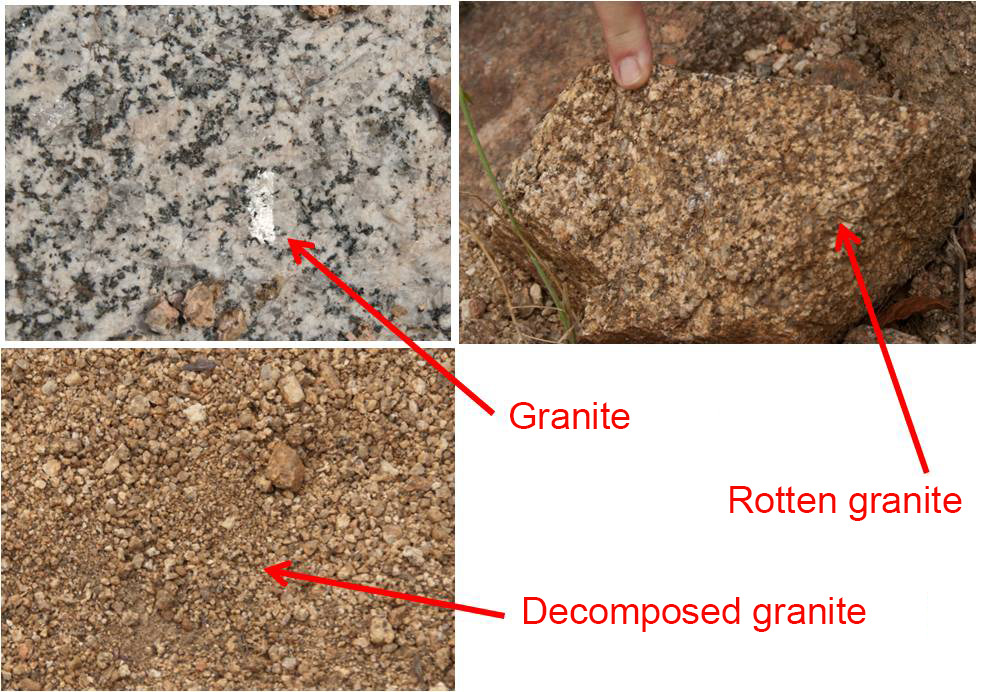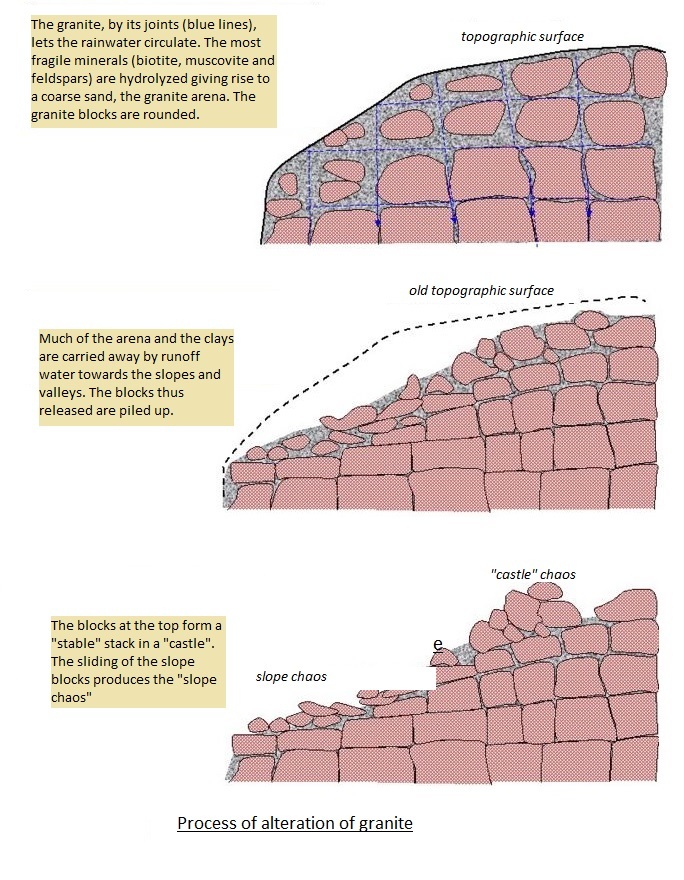
click on the flag to reach the translation

Une Earthcache
Il ne s’agit pas d’une cache physique. Pour loguer cette cache, vous devez dans un premier temps prendre connaissance de sa description éducative en matière de géologie, puis d’observer le site sur lequel vous êtes, et enfin de répondre aux questions qui vous seront posées.
Vous pourrez alors loguer en "Found it" sans attendre mais vous devez me faire parvenir vos réponses en même temps en me contactant soit par mail dans mon profil, soit via la messagerie geocaching.com (Message Center), et je vous contacterai en cas de problème. Les logs enregistrés sans réponses seront supprimés.

Un peu de géologie
> Le granite à grains
Le granite est la roche magmatique plutonique la plus répandue. Son nom vient du fait qu’il est constitué de grains visibles à l’œil nu, de 2 à 5 mm en moyenne. Quand les cristaux sont plus grands, on parle de pegmatite. Quand ils sont plus petits, la structure est microgrenue.
Les principaux minéraux qui constituent un granite sont : le quartz, les feldspaths alcalins, les feldspaths plagioclases et d’autres minéraux comme les micas ou l’amphibole. L’équivalent volcanique du granit est la rhyolite, une roche plus rare.
On peut classer les granits suivant le grain de la roche. Le grain d’un granite désigne la grandeur moyenne des plages constituées par une association de minéraux de même nature.
On distingue les catégories suivantes :
- granite à très gros grain : grain supérieur à 10 mm ;
- granite à gros grain : grain de 3 à 10 mm ;
- granite à grain moyen : grain de 2 à 3 mm ;
- granite à grain fin : grain de 0,5 à 2 mm ;
- granite à grain très fin : grain inférieur à 0,5 mm ;
- microgranite : grain seulement visible au microscope avec parfois quelques grands cristaux visibles à l’œil nu.

> Arénisation du granite
Le granite est une roche dure et résistante mais elle manque de souplesse. Avec les mouvements de l'écorce terrestre et au cours de son refroidissement, le granite fini par se fissurer. Les fractures qu'on appelle également diaclases facilitent l'altération en permettant à l'eau et aux racines des plantes de s'infiltrer plus rapidement au cœur de la roche.
L'eau agit de deux façons différentes :
- par hydratation : l'eau s'additionne à certains composés du granite qui finissent par gonfler puis par se désolidariser de la roche.
- par hydrolyse : l'eau solubilise certains éléments du granite
Les minéraux composant le granite réagissent différemment à l'altération :
- le mica noir, en présence d'eau, s'hydrolyse rapidement en hydroxyde de fer et en argile.
- le quartz est inaltérable
- les feldspaths s'hydrolysent et se transforment en argiles.

Un granite altéré est appelé un "granite pourri", mais l'altération se poursuit et le granite pourri va se transformer en sable grossier pour donner "l'arène granitique"
Composition de l’arène granitique :
- grains de quartz non altérés
- grains de feldspaths restant plus ou moins altérés (surtout le feldspath orthose, plus résistant que les plagioclases)
- oxydes de fer
- argiles (provenant de l’altération par hydrolyse des micas et des feldspaths)
> Transformation du paysage
L’altération du granite pourra continuer en profondeur, par couches (altération en « pelures d’oignon », ou exfoliation, ou desquamation) ce qui formera à la longue des masses plus ou moins arrondies.
L’arène granitique pourra par la suite être emportée par le vent, la gravité et les eaux de ruissellement, dégageant progressivement les blocs de granite non altérés qui resteront empilés les uns sur les autres créant dans le paysage ces structures appelées chaos.
Parfois, l’empilement de ces blocs crée une structure instable où certains blocs ne sont en contact que par un ou deux points de leur surface. Certains blocs peuvent même bouger légèrement lorsqu’on les pousse. Dans les folklores locaux, on nomme souvent ces pierres des « pierres branlantes », « roches tremblantes » ou « pierres folles ».
On peut résumer ce phénomène ainsi :


Questions
Question 0 - Prenez une photo de vous, ou de votre objet distinctif de géocacheur, ou de votre pseudo écrit sur une feuille de papier ou dans votre main... devant ces rochers, et joignez-là à votre log ou à vos réponses
Point d'observation1 (face avant) - Garez-vous comme recommandé (wapypoint parking). Faites attention en franchissant le fossé

Zone A - Voir photo pour la zone précise à observer.
Question 1 - Décrivez cette zone A
Question 2 - Ce phénomène a été causé par
- Arthur qui a essayé Excalibur
- Obelix qui s'est construit un casque audio
- Un phénomène naturel que vous allez décrire dans votre réponse
Question 3 - Comment se nomme la ligne de fracture ?
Question 4 - Quelles raisons à un tel espacement ?
Zone A' - Voir photo pour la zone précise à observer. Cette zone A' est sur la roche côté route perpendiculairement à la zone A intérieure
Question 5 - Décrivez le grain de granite que vous observez au niveau de A'. Quel est le ratio quartz/feldspath ? Quelle est la taille des grains ici (voir catégories de grains dans le leçon)?
Question 6 - Faites la même observation sur le grain de la zone A (paroi intérieure)
Question 7 - Que vous apprend l'observation comparée de A avec A'

Zone B - Voir photo pour la zone précise à observer, à gauche de A.
Question 8 - Qu'observez-vous ici (nommez le processus)?

Zone C - Voir photo pour la zone précise à observer, à droite de A.
Question 9 - Qu'observez-vous ici (nommez le processus)?
Point d'observation2 (face arrière) - Contournez les roches, en tournant autour de C

Zone D - Voir photo pour la zone précise à observer.
Question 10 - Décrivez cette zone D ainsi que le phénomène géologique qui en est à l'origine.


An Earthcache
It is not a physical cache. To log this cache, you must first learn about its educational description in geology, then observe the site on which you are, and finally answer the questions that will be asked.
You can then log in "Found it" without waiting but you must send me your answers at the same time by contacting me either by mail in my profile, or via the messaging geocaching.com (Message Center), and I will contact you in case of problem. Saved logs without answers will be deleted.

A little of geology
> The grain granite
Granite is the most common plutonic magmatic rock. Its name comes from the fact that it consists of grains visible to the naked eye, from 2 to 5 mm on average. When the crystals are larger, we talk about pegmatite. When they are smaller, the structure is micrograined.
The main minerals that make up a granite are: quartz, alkaline feldspars, plagioclase feldspars and other minerals such as micas or amphibole. The volcanic equivalent of granite is rhyolite, a rarer rock.
Granites can be classified according to the grain of the rock. Granite grain refers to the average size of beaches formed by a combination of minerals of the same nature.
The following categories are distinguished:
- very coarse granite: grain greater than 10 mm;
- coarse-grained granite: grain from 3 to 10 mm;
- medium grain granite: 2 to 3 mm grain;
- fine-grained granite: 0.5 to 2 mm grain;
- very fine grain granite: less than 0,5 mm;
- microgranite: grain only visible under a microscope with sometimes some large crystals visible to the naked eye.

> Granite arenization
Granite is a hard and resistant rock but it lacks flexibility. With the movements of the earth's crust and during its cooling, the granite eventually cracks. Fractures, also called diaclases, facilitate weathering by allowing water and plant roots to infiltrate more quickly into the heart of the rock.
Water works in two different ways:
- by hydration: the water is added to certain compounds of the granite which end up swelling and then separating from the rock.
- by hydrolysis: water solubilizes certain elements of the granite
The minerals that make up granite react differently to weathering:
- black mica, in the presence of water, hydrolyzes rapidly to iron hydroxide and clay.
- quartz is unalterable
- feldspars hydrolyze and turn into clays.

Weathered granite is called a "rotten granite", but weathering continues and the rotten granite will turn into coarse sand to give the "granite arena"
Composition of the granite arena:
- unaltered quartz grains
- grains of feldspars remaining more or less altered (especially orthose feldspar, more resistant than plagioclases)
- iron oxides
- clays (from hydrolytic weathering of micas and feldspars)
> Landscape transformation
The alteration of the granite may continue in depth, in layers (alteration in "onion peels", or exfoliation, or peeling) which will eventually form more or less rounded masses.
The granite arena can then be carried away by wind, gravity and runoff, gradually releasing the unaltered granite blocks which will remain stacked on top of each other creating in the landscape these structures called chaos.
Sometimes, the stacking of these blocks creates an unstable structure where some blocks are in contact only at one or two points of their surface. Some blocks can even move slightly when pushed. In local folklore, these stones are often referred to as "rocking stones", "trembling rocks" or "crazy stones".
We can summarize this phenomenon as follows:


Questions
Question 0 - Take a picture of yourself, or your distinctive geocacher item, or your written nickname on a sheet of paper or in your hand... in front of these rocks, and attach it to your log or your answers
Observation point1 (front face) - Park as recommended (wapypoint parking). Be careful crossing the gap

Area A - See photo for the precise area to observe.
Question 1 - Describe this area A
Question 2 - This phenomenon was caused by
- Arthur who tried Excalibur
- Obelix who built himself a headset
- A natural phenomenon that you will describe in your answer
Question 3 - What is the fracture line called?
Question 4 - What are the reasons for such spacing?
Area A' - See photo for the precise area to observe. This zone A' is on the rock on the road side perpendicular to the inner zone A
Question 5 - Describe the grain of granite that you observe at level A'. What is the quartz/feldspar ratio? What is the grain size here (see grain categories in the lesson)?
Question 6 - Make the same observation on the grain of area A (inner wall)
Question 7 - What does comparing observation of A with A' tell you

Area B - See photo for the precise area to observe, to the left of A.
Question 8 - What do you observe here (name the process)?

Area C - See photo for the precise area to observe, to the right of A.
Question 9 - What do you observe here (name the process)?
Observation point 2 (back side) - Go around the rocks, turning around C

Zone D - See photo for the precise area to observe.
Question 10 - Describe this area D and the geological phenomenon that caused it.< /p>